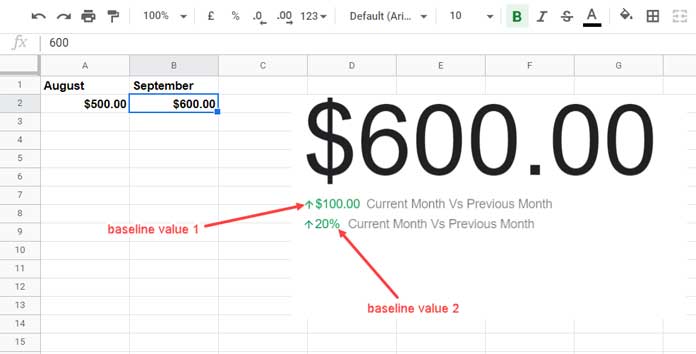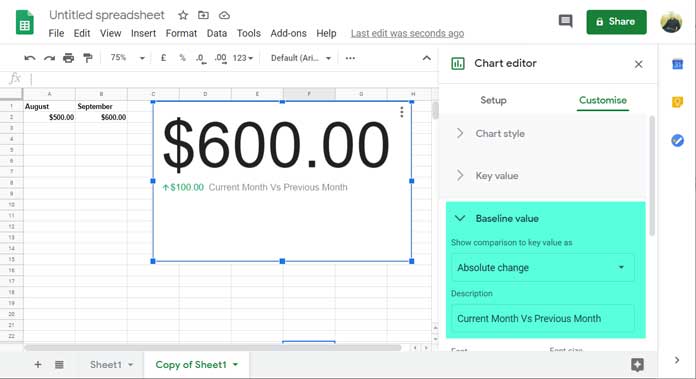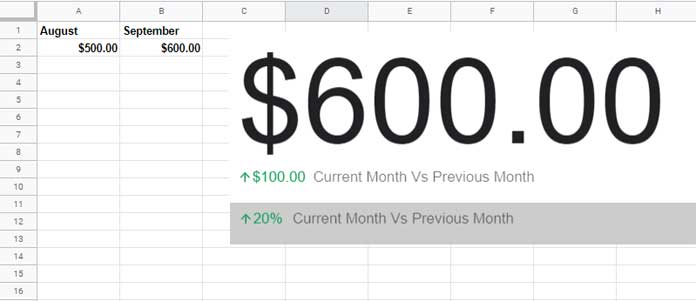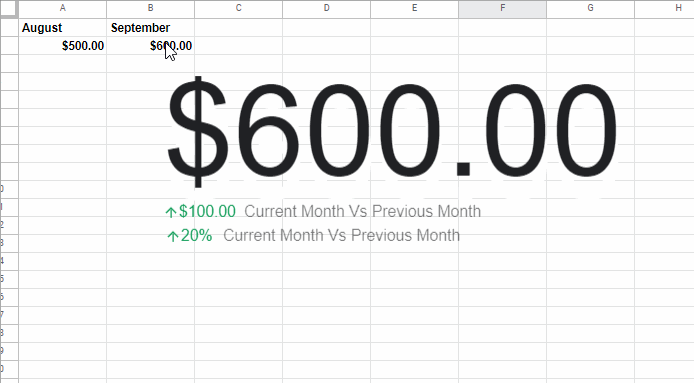At present, there are two baseline values to select from in a scorecard chart in Google Sheets.
They are absolute change value and percentage change value. But, ironically, we can only select either of the ones to display on the scorecard chart.
With an easy to implement workaround, we can show two baseline values in ‘a’ scorecard chart.
It’s by creating two scorecard charts from the same values (key performance indicators aka KPIs).
One with all the required parameters and the other with only the baseline value parameter.
Here in the following example, you can see two baseline values below a key value.

Baseline Values in Scorecard Chart (Introduction)
The key value and baseline values are the two main elements in the scorecard in Google Sheets.
In the above example, $600 is the key value. Below that you can see two baseline values.
As far as I am concerned, without a baseline value (or multiple baseline values), the scorecard chart is lifeless.
I mean, the chart will look just like a text object that contains a number instead of a text, that updates based on a cell value (useful to call attention to KPIs).
That means the baseline value makes the scorecard chart lively. It reveals the relation of a baseline value with a key value in two different modes. They are;
- Absolute change – the formula is
key_value-baseline_value, i.e. as per the above example;=B2-A2 - Percentage change – the formula is
key_value/baseline_value*100%-100%, i.e. as per the above example;=to_percent(B2/A2*100%-100%)
In the above example, ↑$100 is the absolute change value and ↑20% is the percentage change value.
But as per the scorecard customization settings, we can only display either of the ones!
Here is a workaround to get two baseline values (percentage change and absolute change) in a scorecard chart in Google Sheets.
Workaround to Get Two Baseline Values in a Scorecard Chart
Creating the Chart
Assume, the cells A2 and B2 contain my income from content creation for the month of August and September respectively.
Let’s first create a scorecard chart based on these two values (KPIs).
Click on any blank cell, for example, cell D2. Then click on the menu Insert > Chart and select “Scorecard chart” under the “Chart type” from the sidebar panel.

On the panel, under “Key value” select cell B2 and under “Baseline value” select cell A2.
Your scorecard chart with one baseline value is ready.
Please note that the default baseline value will be “Absolute change” if not change it to “Absolute change” (see the image below).
Go to the “Customize” tab and made the basic required customization.
Here I am just changing the baseline value font size to 18 and adding a custom description (you can put your own description).

Then under “Chart style” in the same customization panel, change the chart “Border color” to “None” and “Background color” to “Grey”.
We will later change this “Grey” color to “White” or transparent (“None”).
Click on the chart and drag it to the correct/required position. Ideally, make sure that the chart’s top edge is on the 4th row (you can refer to the image below).
Then click on the chart to select it and then point your mouse over the middle square dot at the bottom of the chart.
Drag to the top to reduce the chart width. Make sure that you leave only minimal spaces below the baseline value on the chart.

Workaround to Add Two Baseline Values in the Scorecard Chart
Let’s make a copy of the above chart.
For that, click on cell D1, then click on the chart, then tap Ctrl+C, Ctrl+V.
This way we can create an exact copy of the first chart in Google Sheets.
On this second chart, change the background color to “White” and change the Baseline value to “Percentage change”.
Now the charts should look like as below.

If both the charts are not aligned as above drag and adjust the charts accordingly.
Just change the first chart background color from Grey to White and voila!
This way we can show two baseline values in a scorecard chart in Google Sheets.
Additional Tips (Transparent Background)
If you want transparent background, you should follow the below steps.
First Chart (the chart on the bottom): Make “Background color” to “None” and “Key value” color to “White”.
Second Chart (the chart on the top): Make “Background color” to “None”.

That’s all. Enjoy!





















